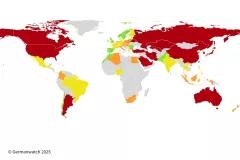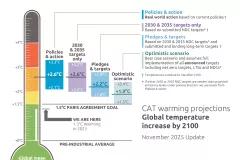Click here for the briefing.
From the perspective of the Climate Action Tracker, the Paris Agreement will positively influence the world’s ability to limit the adverse effects of climate change.
For the first time, an international climate agreement has, at its core, a goal to not just hold warming below 2°C, but critically specifies this goal as holding warming well below 2°C and to pursue efforts to limit the temperature increase to 1.5°C above pre-industrial levels.
In addition, and as another first, this agreement looks beyond emissions reductions over the near term, and specifies that anthropogenic greenhouse gas emissions and removals have to “balance” in the 2nd half of the century.
We interpret the latter as global anthropogenic greenhouse-gas emissions needing to reach zero, and note that IPCC scenarios assessed in the UNEP emissions gap reports show that this emissions objective fits with the temperature limits, if this is achieved by 2060-2080.
As the CAT has previously noted, the national mitigation contributions, now associated with the Paris Agreement, would lead to a median warming of around 2.7°C by 2100 (a full range of 2.2-3.4°C, which means there is a likely chance of holding warming below 3°C, temperature would continue to rise after 2100).
Compared to the 3.6°C by 2100 warming that is projected to result from current policies, the climate pledges submitted in the INDCs lower warming by about 0.9°C – but only if all governments fully implement their pledges.
The national contributions are, in aggregate, also not yet consistent with the global emissions objective for the 2nd half of the 21st century.
A positive element in the agreement is therefore that countries are asked to ‘formulate and communicate long-term low greenhouse gas emission development strategies.’ Developed countries that already have 2050 targets can review their plans in the context of the agreed goals, as most of these plans must be strengthened, and developing countries can build on the experience of the INDC process to work from existing plans and develop longer-term visions.
Elements crucial to raising the ambition in the Paris Agreement are:
- Provisions to update the actions of countries every five years, while each successive step has to be at least as strong as the current one. This can start with a government submitting an updated climate pledge when it ratifies the agreement. Then new or renewed contributions for 2030 have to be submitted 9-12 months in advance of the Conference of the Parties in 2020.
- A government can adjust its contribution to enhance its climate action pledge at any time.
- Individual review of the actions will include suggestions for improvement for each country.
- A global stocktake will regularly measure progress, starting 2018.
- A facilitative implementation committee will assist governments in implementing their pledged actions.
- Countries will continue to work together to increase ambition before 2020.
Of the 32 INDCs rated by the CAT, covering around 81% of global emissions, we have rated only five as “sufficient” covering only 0.4% of global emissions, while 26 INDCs are not sufficient.
We have rated 11, covering 62% of global emissions as “medium,” and 15, covering 19% of global emissions as "inadequate."
In accordance with their fair-share, nearly all individual governments need to enhance their 2025 or 2030 contributions in order to achieve the Paris Agreement’s purpose of holding warming below 2°C, or limiting to 1.5°C, above pre-industrial levels.
Conditional elements of INDCs provide a good starting point for enhancing ambition. Meeting all conditional mitigation contributions could lead to reducing the emissions gap between INDCs and 1.5 and 2°C by roughly 2.8 GtCO2e (12-17%) in 2030, if conditions are met.
Prof. Niklas Höhne, NewClimate Institute
“This historic agreement sets the direction. From tomorrow, work has to start to raise ambition. The current contributions are the ‘floor of ambition’ and more can and will be done.”
Prof. Kornelis Blok, Ecofys
"Countries have taken a huge step away from dangerous climate change. But under current commitments we are still heading for a temperature increase above 2 degree C, let alone or 1.5 degrees. So, we need a further strengthening of the commitments. This should be an important topic for the first stocktaking in 2018. Non-state actors are invited to scale up their efforts. The emissions gap could be further closed if companies and cities set targets and live up to them."
Dr Louise Jeffery, Potsdam Institute for Climate Impact Research
“Under the Paris Agreement, governments are asked to formulate and communicate long-term low emissions development strategies. These development strategies are an opportunity to build on experiences from the INDC process and can help to further elaborate on how the 1.5°C and 2°C temperature objectives can be achieved.”
Dr Marcia Rocha, Climate Analytics and CAT Project Leader
“With provisions in place to ratchet up efforts in successive five-year periods, I believe the Paris Agreement provides sufficient room to improve. Given the cycles of the IPCC to produce its crucial updates on science and condition of the climate system, and its impacts, which are roughly in sync with this Agreement, I have confidence that this process will continue to be a science-driven process and that countries will continue to find real national solutions to jointly solve a very real global problem.”







